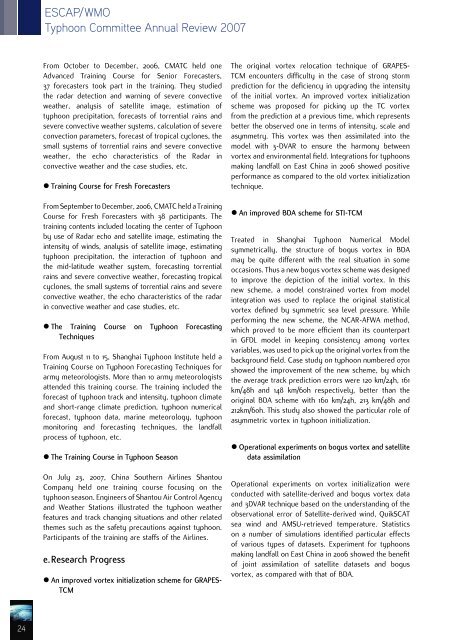200 - Typhoon Committee
200 - Typhoon Committee
200 - Typhoon Committee
You also want an ePaper? Increase the reach of your titles
YUMPU automatically turns print PDFs into web optimized ePapers that Google loves.
ESCAP/WMO<br />
<strong>Typhoon</strong> <strong>Committee</strong> Annual Review <strong>200</strong>7<br />
From October to December, <strong>200</strong>6, CMATC held one<br />
Advanced Training Course for Senior Forecasters,<br />
37 forecasters took part in the training. They studied<br />
the radar detection and warning of severe convective<br />
weather, analysis of satellite image, estimation of<br />
typhoon precipitation, forecasts of torrential rains and<br />
severe convective weather systems, calculation of severe<br />
convection parameters, forecast of tropical cyclones, the<br />
small systems of torrential rains and severe convective<br />
weather, the echo characteristics of the Radar in<br />
convective weather and the case studies, etc.<br />
• Training Course for Fresh Forecasters<br />
The original vortex relocation technique of GRAPES-<br />
TCM encounters difficulty in the case of strong storm<br />
prediction for the deficiency in upgrading the intensity<br />
of the initial vortex. An improved vortex initialization<br />
scheme was proposed for picking up the TC vortex<br />
from the prediction at a previous time, which represents<br />
better the observed one in terms of intensity, scale and<br />
asymmetry. This vortex was then assimilated into the<br />
model with 3-DVAR to ensure the harmony between<br />
vortex and environmental field. Integrations for typhoons<br />
making landfall on East China in <strong>200</strong>6 showed positive<br />
performance as compared to the old vortex initialization<br />
technique.<br />
From September to December, <strong>200</strong>6, CMATC held a Training<br />
Course for Fresh Forecasters with 38 participants. The<br />
training contents included locating the center of <strong>Typhoon</strong><br />
by use of Radar echo and satellite image, estimating the<br />
intensity of winds, analysis of satellite image, estimating<br />
typhoon precipitation, the interaction of typhoon and<br />
the mid-latitude weather system, forecasting torrential<br />
rains and severe convective weather, forecasting tropical<br />
cyclones, the small systems of torrential rains and severe<br />
convective weather, the echo characteristics of the radar<br />
in convective weather and case studies, etc.<br />
• The Training Course on <strong>Typhoon</strong> Forecasting<br />
Techniques<br />
From August 11 to 15, Shanghai <strong>Typhoon</strong> Institute held a<br />
Training Course on <strong>Typhoon</strong> Forecasting Techniques for<br />
army meteorologists. More than 10 army meteorologists<br />
attended this training course. The training included the<br />
forecast of typhoon track and intensity, typhoon climate<br />
and short-range climate prediction, typhoon numerical<br />
forecast, typhoon data, marine meteorology, typhoon<br />
monitoring and forecasting techniques, the landfall<br />
process of typhoon, etc.<br />
• The Training Course in <strong>Typhoon</strong> Season<br />
On July 23, <strong>200</strong>7, China Southern Airlines Shantou<br />
Company held one training course focusing on the<br />
typhoon season. Engineers of Shantou Air Control Agency<br />
and Weather Stations illustrated the typhoon weather<br />
features and track changing situations and other related<br />
themes such as the safety precautions against typhoon.<br />
Participants of the training are staffs of the Airlines.<br />
e. Research Progress<br />
• An improved vortex initialization scheme for GRAPES-<br />
TCM<br />
• An improved BDA scheme for STI-TCM<br />
Treated in Shanghai <strong>Typhoon</strong> Numerical Model<br />
symmetrically, the structure of bogus vortex in BDA<br />
may be quite different with the real situation in some<br />
occasions. Thus a new bogus vortex scheme was designed<br />
to improve the depiction of the initial vortex. In this<br />
new scheme, a model constrained vortex from model<br />
integration was used to replace the original statistical<br />
vortex defined by symmetric sea level pressure. While<br />
performing the new scheme, the NCAR-AFWA method,<br />
which proved to be more efficient than its counterpart<br />
in GFDL model in keeping consistency among vortex<br />
variables, was used to pick up the original vortex from the<br />
background field. Case study on typhoon numbered 0701<br />
showed the improvement of the new scheme, by which<br />
the average track prediction errors were 120 km/24h, 161<br />
km/48h and 148 km/60h respectively, better than the<br />
original BDA scheme with 160 km/24h, 213 km/48h and<br />
212km/60h. This study also showed the particular role of<br />
asymmetric vortex in typhoon initialization.<br />
• Operational experiments on bogus vortex and satellite<br />
data assimilation<br />
Operational experiments on vortex initialization were<br />
conducted with satellite-derived and bogus vortex data<br />
and 3DVAR technique based on the understanding of the<br />
observational error of Satellite-derived wind, QuikSCAT<br />
sea wind and AMSU-retrieved temperature. Statistics<br />
on a number of simulations identified particular effects<br />
of various types of datasets. Experiment for typhoons<br />
making landfall on East China in <strong>200</strong>6 showed the benefit<br />
of joint assimilation of satellite datasets and bogus<br />
vortex, as compared with that of BDA.<br />
24
















